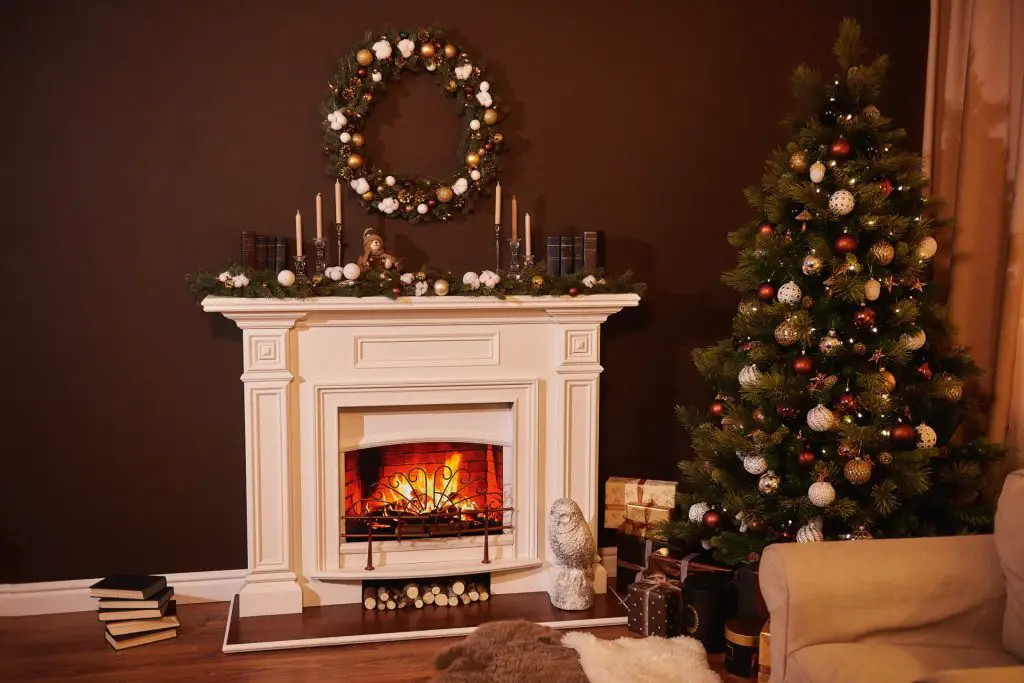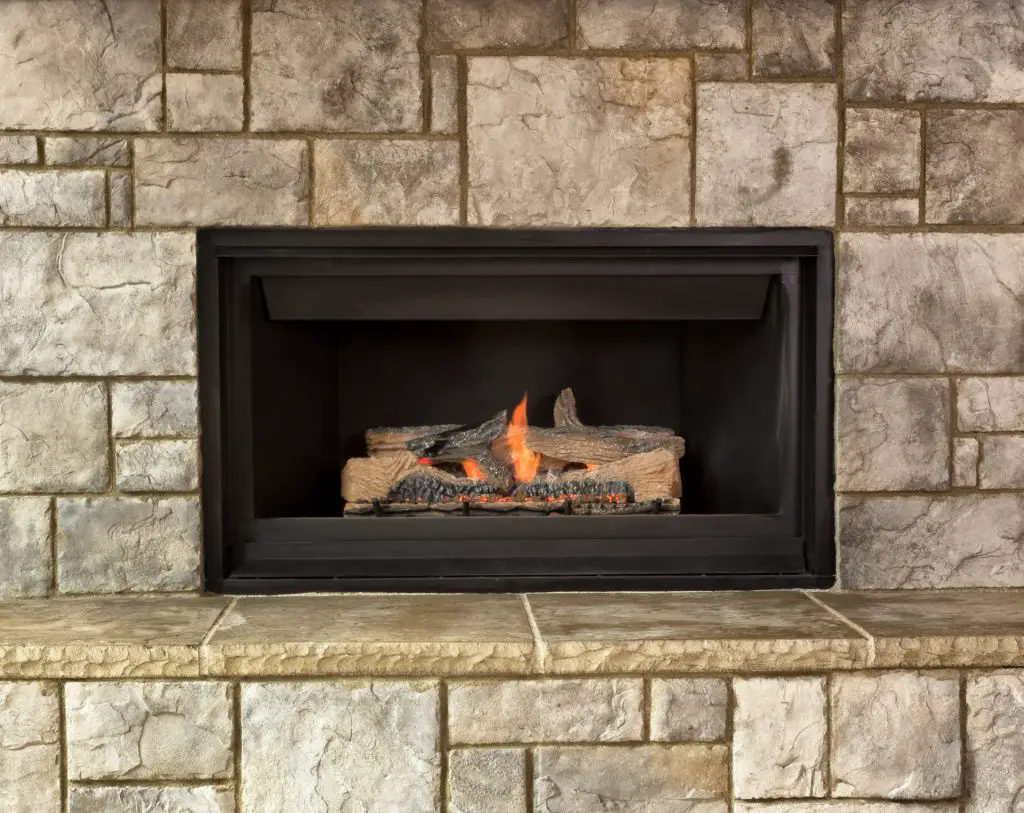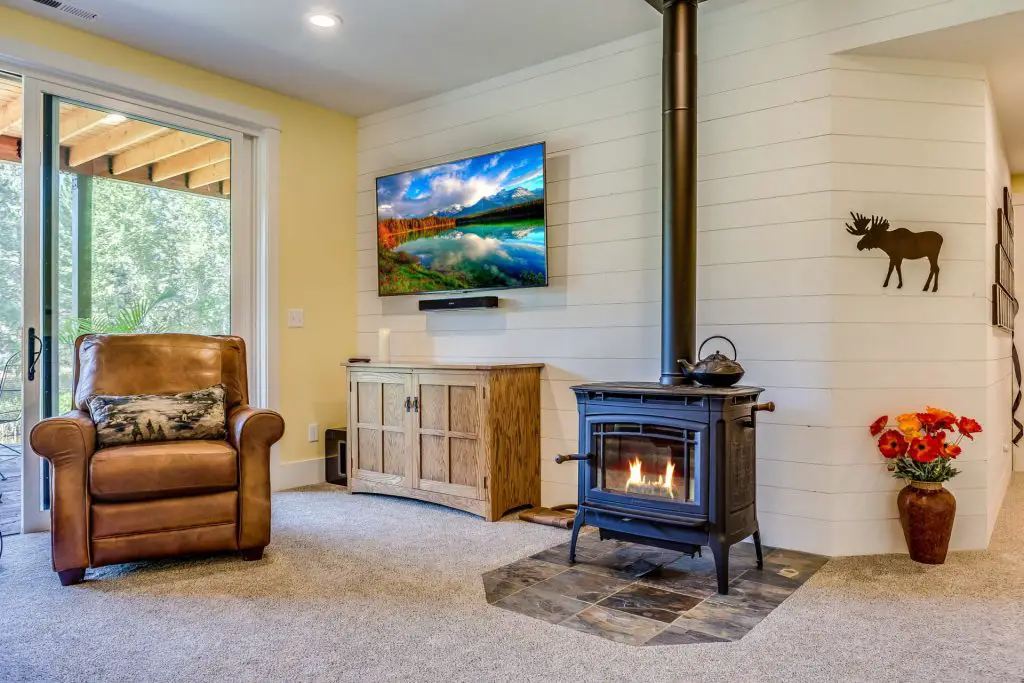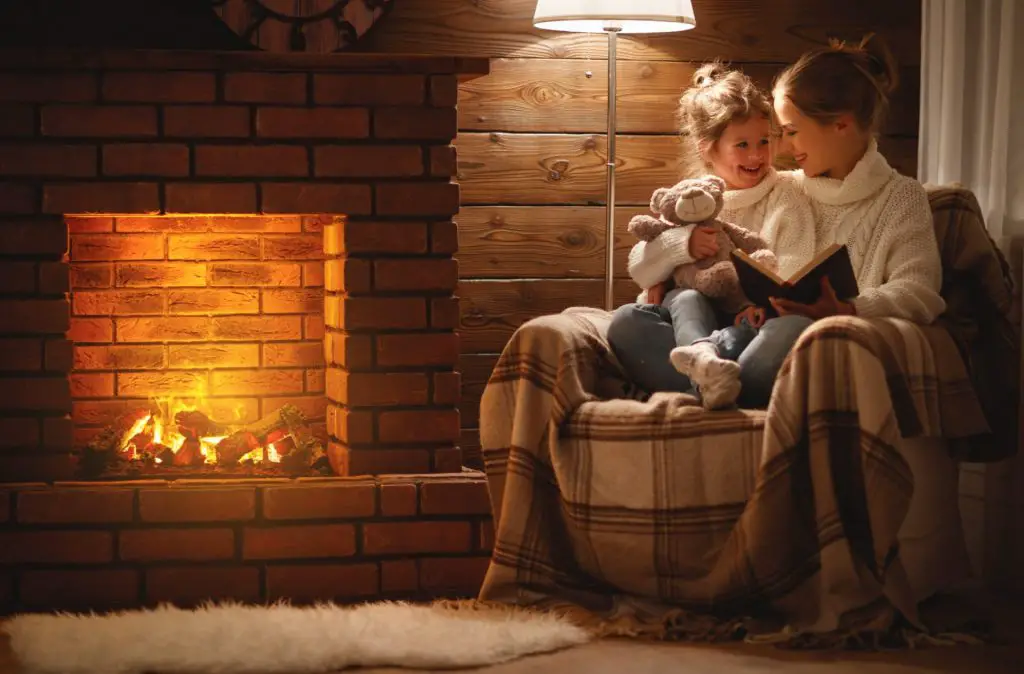Wood fireplaces are an excellent source of heat. But they are not only used for this- they can also be used to create a wonderful atmosphere in your house. They are also relatively easy to maintain.
The firewood burns more slowly than coal or coke, which provides a steadier, more controllable heat over a longer period of time.
Wood fireplaces can produce more smoke and pollutants than an electric or gel fireplace, but people love that distinctive wood-burning smell.
They are the most classic type of fireplace you can buy.
Contents
- How are they different than gas, electric, and ethanol?
- Wood burning costs
- Types
- Wood Fireplace Inserts
- Pros
- Cons
- Wood Stoves
- Pros
- Cons
- Wood Burning Fireplaces
- Pros
- Cons
- How To Build A Fire
- Cleaning/Preparing the Fireplace
- Choosing the Wood
- Building the Fire
- The Traditional Method
- The Top-Down Method
- Keeping A Fire Going
- Extinguishing the Fire
- Types Of Venting
- Air-Cooled Chimney System
- Insulated Chimneys
How are they different than gas, electric, and ethanol?

Fireplaces have been a beloved part of homes for centuries. They are used for a lot of decorating purposes, but some are still used for heating. There are multiple types of fireplaces including, but not limited to gas, electric, and ethanol.
A fireplace works by burning a wood product to heat a room, house, or area. The smoke escapes through the chimneys, so the smoke is not constantly being inhaled by the home tenants. Make sure you know what to do if your fireplace is smoking.
The most significant difference in the types of fireplaces available is what they burn. There are many differences between wood, gas, electrical, and ethanol appliances.
The heat output, the venting, venting pipes, type of fuel needed, insulation, source of heat, actual burn time, clearance requirements, size, exhaust, and exhaust pipes are quite a few differences, but there are many more.
(Learn how to get the most heat out of your fireplace– it’s worth it!)
Wood burning fireplaces are good if you want an authentic experience to roast chestnuts and have access to cheap wood. (As well as a classic space to hang your Christmas stockings!)
However, it can be an expensive installation and they’re pretty inefficient- most of the heat escapes up the chimney (Source).
There’s also the chimney maintenance you have to worry about.
Electric, gas, and ethanol are much more portable, easy to install, but do lack the atmospheric effects of wood-burning fireplaces. They can also increase your electric bill.
Wood burning costs
The price range to install a new wood fireplace is estimated to be between 860 dollars and 3,500 dollars. Various studies have shown that owning a wood fireplace is much more cost-effective than other kinds, such as an electric version.
The cost of material to use in a wood stove is also much cheaper than buying gas or paying for electricity- usually. If you have access to free wood- this is especially true.
Types
Wood Fireplace Inserts

A fireplace insert is an insert that is placed in a pre-used fireplace. These are typically fire-proof steel boxes used to avoid fires while still having a modern look.
Most of the inserts available have a door with a glass window to keep the flames and such inside while people can still enjoy the view. Some manufactured inserts also come with a fan for circulation of the heat. These insert manufacturers give people a variety of style options.
The modern style of inserts is one reason they are popular. The venting systems on inserts make way for clean, warm air, and the smoky air gets cleared by the venting. These wood-burning systems are sometimes made of metal and called a metal firebox.
Pros
Wood fireplace inserts have a higher heat output than a conventional masonry fireplace because of the venting. Having a wood insert is way less likely to cause a fire than having a traditional fireplace. Wood-burning inserts are one of the most attractive options as rated by many consumers.
Cons
Wood fireplace inserts need their exhaust connector and flue. A new liner would also have to be purchased because using one already in the fireplace could cause a fire due to creosote buildup—the smoke stacks in the chimneys, causing the creosote, which causes pollution.
Wood Stoves

Wood burning stoves are heating appliances that burn wood fuel. Usually, these appliances are made of a metal firebox.
The stoves are used by connecting a ventilating pipe to a flue that will fill with combustion gas after the ignition of the stove.
The combustion gasses are brought out through the chimney connected to the stove. Regulation of air is significant for these appliances to ensure safety which may be done by adding moist products. A moisture meter may be used in this case. The type of wood also preferred matters for the stove, the heat, and the airflow.
Some types of wood include seasoned wood, soft wood, split wood, portable wood, green wood, and wet wood. There are also other types of stoves such as a gas stove, electric stove, and non-catalytic stove.
However, there are pros and cons to all types of stoves. When deciding on a stove, you also need to know the parts to ensure safety. Some pieces created for safety and airflow are the heat shield, outer walls that should be kept cool, stove pipes for ventilation, wood burners, and larger pieces.
When deciding on the type of stove, there are some viable options such as appliance depth, appliance heigh, and appliance depth.
If you’ve installed a corner fireplace, learn how to decorate them!
Pros
Wood stoves use fossil fuels and are all-around more eco-friendly than ever before. Wood stoves are also much cheaper than alternatives since you can burn your wood and not worry about monthly bills or expensive fuels.
These stoves are also very efficient at around 80 percent of heat used to heat someone’s home instead of escaping through the chimney. The fires are also longer lasting.
Cons
The installment process may take longer and be more expensive compared to other appliance types. These stoves may also get dangerously hot.
Wood Burning Fireplaces

There are multiple types of fireplaces, including electric fireplaces, gas fireplaces, wood fireplaces, and traditional fireplaces.
With these comes various style choices, including the classic style fireplace to create an authentic look and modern style. Knowing these helps people choose a fireplace with ease.
The smoke caused by wood-burning fireplaces escapes from the chimney it is connected to. The chimney and fireplace connection can sometimes be a time-consuming process as there are so many details.
The chimney’s primary purpose is to filter the smoke, heat, and air quality. A chimney’s insulation makes less draft and more heat to better heat a home. Here’s how to deal with a drafty fireplace and chimney. They also turn energy into heat. Make sure you get yourself a hearth rug to protect your living room from spitting embers!
Pros
There are many great reasons to use a wood-burning fireplace. They are more eco-friendly than options like gas and electric versions. This option can heat during power outages, whereas other options need electricity to burn.
Wood is excellent when it is the only heat source in a home. The bills are cheaper because you just must pay for your wood.
Central heating can be costly. These fireplaces are also easy to maintain because of the natural burning material. Plus you can paint your brick fireplace if it needs a makeover! Or even give it a whitewash.
Cons
People will have to buy or chop their wood and give it time to dry before using it, which costs money and takes more time. It can be dangerous to leave the fire without a chaperone due to the heat and ashes, and a fire may start. Sometimes there is a draft from the chimney year-round because of the open chimney.
How To Build A Fire
Cleaning/Preparing the Fireplace
Before preparing the fireplace, it is a good idea to clean the chimney. Creosote buildup can happen, and when it does, it should be cleared. The next step would be clearing the leftover ashes and residue.
Clearing the fire is vital to keep the fireplace clean. The residues can block airflow and leave an odor.
Inspect the chimney and fireplace for cracks, broken or missing parts, and structural problems. Sweep or clean the chimney walls to get rid of creosote build-up and residue. Installing a chimney cap and fireplace safety cover spark screen is also a step to ensure a chimney is ready for use.
A chimney cap goes over the chimney to protect against rain or snow. If there is an issue with any preparations or cleaning, there are also professionals that can be called. Don’t forget to clean the mantle, as well!
Choosing the Wood
Seasoned and dry wood is the best for a wood appliance. Hardwood is the best to burn, but the type almost wholly depends on personal preferences.
The best types of hardwood to burn are oak, cherry, mulberry, and ash. Softwoods are loaded with sap, so they build up creosote if used as more than a fire starter. Different wood can produce different fire colors!
Building the Fire
The Traditional Method
The first step is to open your flue and then set two dry pieces of wood into your fireplace. Then add a few pieces of paper and some small pieces of wood. Ensure that there is some space between the wood to allow ventilation. Hold a piece of fiery paper to the flue to reverse the draft away from where you want your fire. Ignite in multiple spots for the best chance of getting the fire started and add new logs as they are needed.
The Top-Down Method
The top-down method is less common, but many people find it easier than the traditional way. The idea of this is to put large pieces of wood down and stack smaller pieces on top, creating a triangular shape. Add small pieces on the top to ignite to start the fire. This version will create far less smoke than the traditional way.
Keeping A Fire Going
The best way to keep a fire going is by getting small pieces of wood called kindling or tinder to throw into the fire periodically- it’s important to learn how to stack wood in your fireplace, as a start. People also need to use dry wood as moisture will cease-fire. Start a fire with softwood because it burns faster and will create larger fires, replace with hardwood. Making sure that the fire has enough oxygen is essential because, without it, a fire will “suffocate” and die out.
Extinguishing the Fire
To extinguish a fire, use a fire poker to spread the ember and wood and then cover them with ash to put them out. Add baking powder over the ashes and then put them into a metal container, storing them away from flammable as a precaution.
Using water is not recommended because it will take much water and make a huge mess. Unlike outdoor fire, using water in a fireplace may make the fire bigger instead of putting it out.
Types Of Venting
Air-Cooled Chimney System
This type of chimney system is more cost-effective and more lightweight than an insulated version. This may make chimney installation easier. This type of venting allows for gases to be released faster. This causes heats up, causes draft, and cools down quickly. This also needs standard clearance.
Insulated Chimneys
These chimneys must maintain a 2-inch clearance to pipes. The insulation Is used to keep creosote from building up within the chimney. The insulation is designed for metal-lined chimneys.
Today’s fireplaces are not like what they used to be. They were once built to withstand the cold winters and provide warmth for the house. Today, people mainly use them as decorations, but they can still provide warmth and comfort for you.
So why are wood fireplaces great? Well, they’re not only good-looking but functional too. You can create an ambiance with a wood fireplace that is perfect for any occasion.
Wood fireplaces are great because they’re stylish and functional. Not only do you get the warmth of a fireplace without the mess of ashes or soot on your floor, but you also have many options when it comes to style – from rustic designs to modern ones!

